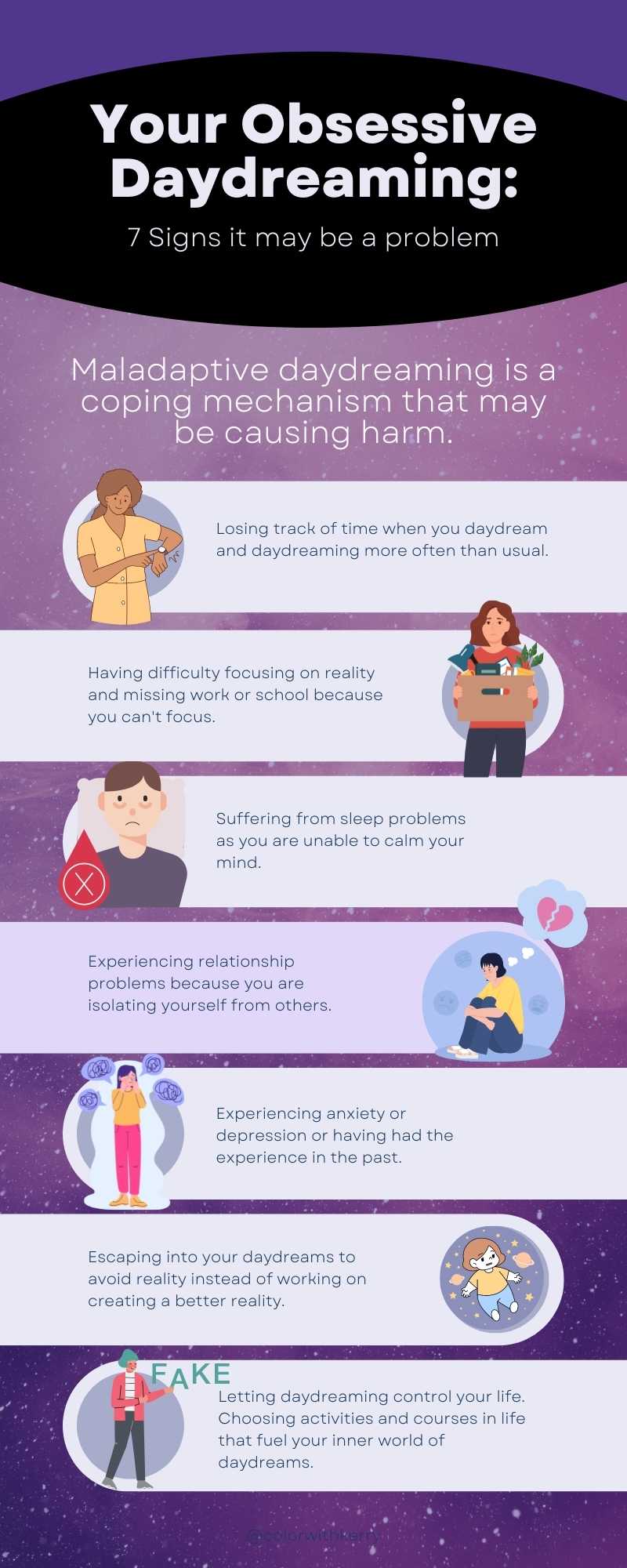- Signs Maladaptive Daydreaming might be a problem for you
- What Causes Maladaptive Daydreaming?
- Links you may find helpful
- Support Groups
- What Makes Maladaptive Daydreaming So Maladaptive?
- How Is It Diagnosed?
- Helpful Videos
- How Is It Treated?
- What is a maladaptive daydreaming coping mechanism
- Conclusion:
Do you sometimes daydream about having a better life? A life where you're more successful, more popular, or happier? If so, then you're not alone. In fact, daydreaming about a better life is perfectly normal. What's not normal is when those daydreams become all-consuming and start to interfere with your real life. That's what's known as maladaptive daydreaming.
Maladaptive coping mechanisms are those that are ineffective in resolving problems or in achieving goals. They may actually worsen the problem or lead to negative consequences.
Maladaptive daydreaming (sometimes known as daydreaming disorder) is a form of excessive daydreaming - similar to my own maladaptive daydreaming experience - that can interfere with your ability to function in everyday life. People who suffer from this condition often have very vivid and detailed daydreams that they escape into for hours at a time. As a result, they may start to withdraw from real-life relationships and activities in order to spend more time on their fantasy world. In extream cases they may even believe that their daydreams are more real than reality itself.
Signs Maladaptive Daydreaming might be a problem for you

A few ways maladaptive dreaming might be causing problems in your life.
-Losing track of time when you daydream
-Having difficulty focusing on reality
-Daydreaming more often than usual
-Escaping into your daydreams to avoid reality
-Experiencing anxiety or depression
-Isolating yourself from others
-Experiencing relationship problems
-Missing work or school because you can't focus
-Suffering from sleep problems
What Causes Maladaptive Daydreaming?
The exact cause of maladaptive daydreaming is unknown. However, it is thought to be linked to traumatic events or experiences in early childhood. Those who suffer from this condition often have a history of abuse, neglect, or trauma. Other risk factors include social isolation, anxiety, and depression.
Links you may find helpful
A collection of links I have discovered to help understand my daydreaming habit.
Somer Clinic
Youtube channel of one of Dr Somer one of the origional researcher into the Maladaptive Daydreaming condition.
The Sleep Foundation
What is Maladaptive Daydreaming
The Dreaming Place
Resources for Maladaptive Daydreaming
Cleveland Clinic
Maladaptive Daydreaming Overview
Healthline
Symptoms of maladaptive daydreaming
WebMD
Maladaptive Daydreaming Explained
Support Groups
It can be helpful to know you are not going it alone.
A Facebook group to find help and support
What Makes Maladaptive Daydreaming So Maladaptive?
Several things make maladaptive daydreaming so harmful to those who suffer from it. First, as mentioned above, it usually occurs in response to stress or trauma. This means that it can be triggered by things like bullying, abuse, or neglect. Additionally, maladaptive daydreaming can cause a person to feel disconnected from reality. This can lead to problems in school or work, as well as in personal relationships. Finally, because people who suffer from maladaptive daydreaming often have difficulty concentrating on tasks, they may withdraw from social interaction. This can make it difficult to make friends or keep a job.
A maladaptive daydreaming coping mechanism is to focus on the present moment. Mindfulness techniques such as meditation, yoga, and art can help train the mind to stay focused in the now and not wander away into daydreams. Additionally, cognitive behavioral therapy (CBT) can be beneficial in helping sufferers of maladaptive daydreaming learn how to manage their thoughts and feelings better.
How Is It Diagnosed?
A formal diagnosis for maladaptive daydreaming is yet to be defined. However, if you feel like your daydreams are interfering with your ability to function in everyday life, it might be worth speaking to a mental health professional about it. What can be useful when seeking help is to record your daydreams in a journal and look for patterns. A therapist will be able to help you deep dive into your mind will be able to help you understand what you're going through and provide some tips on how to cope with it.
Helpful Videos
I curated a selection of videos I felt were helpful for those interested in Maladaptive daydreaming.
How Is It Treated?
There is no one-size-fits-all treatment for maladaptive day dreaming. However, there are some things that might help. These include therapy, medications, and self-help strategies such as journaling or mindfulness meditation. If you think you might be suffering from this condition, it's important to speak to a mental health professional so they can help you find the right treatment plan for you.
In the end however, daydreaming is such an integral part of how the brain processes the word that to refrain from daydreaming altogether would be a near impossible task and even undesirable feat to eliminate it all together. Learning to live with maladaptive behavioral tendencies may be more realistic. That said, it is still worth seeking professional help.
What is a maladaptive daydreaming coping mechanism
Maladaptive daydreaming is a coping mechanism that has recently been gaining attention in the psychological communities. It can be a sign of an underlying behavioral addiction and is becoming increasingly more severe with longer and more complex maladaptive daydreams. To measure maladaptive daydreaming, experts use something called the maladaptive daydreaming scale, which acts as a metric to recognize maladaptive behavior and find ways to cope with it. By seeking help from professionals, maladaptive daydreamers have an outlet to express their imagination without causing damage to their mental health. Ultimately, maladaptive daydreaming is a form of coping, albeit one that requires oversight in order for it to serve its purpose in the most effective way possible.
Conclusion:
Maladaptive daydreaming is a form of excessive daydreaming that can interfere with your ability to function in everyday life. If you think you might be suffering from this condition, it's important to speak to a mental health professional so they can help you find the right treatment plan for you.
There is no one-size-fits-all treatment for maladaptive daydreaming; however, there are some things that might help, including therapy, medication, and self-help strategies such as journaling or mindfulness meditation. With the right treatment plan and some effort on your part, it is possible to learn how to manage your condition and live a happy and fulfilling life despite it.
Thanks for reading!


